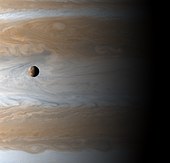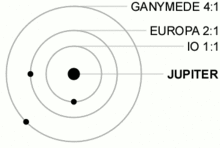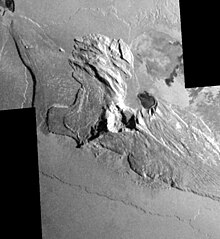Io (moon)
[12][13][14] This extreme geologic activity is the result of tidal heating from friction generated within Io's interior as it is pulled between Jupiter and the other Galilean moons—Europa, Ganymede and Callisto.
The materials produced by this volcanism make up Io's thin, patchy atmosphere, and they also greatly affect the nature and radiation levels of Jupiter's extensive magnetosphere.
In 1979, the two Voyager spacecraft revealed Io to be a geologically active world, with numerous volcanic features, large mountains, and a young surface with no obvious impact craters.
[30] Since the surface was first seen up close by Voyager 1, the International Astronomical Union has approved 249 names for Io's volcanoes, mountains, plateaus, and large albedo features.
[32] Based on ephemerides produced by astronomer Giovanni Cassini and others, Pierre-Simon Laplace created a mathematical theory to explain the resonant orbits of Io, Europa, and Ganymede.
[36] Improved telescope technology in the late 19th and 20th centuries allowed astronomers to resolve (that is, see as distinct objects) large-scale surface features on Io.
[42] Radio tracking provided an improved estimate of Io's mass, which, along with the best available information of its size, suggested it had the highest density of the Galilean satellites, and was composed primarily of silicate rock rather than water ice.
The camera on board Pioneer 11 took the only good image of the moon obtained by either spacecraft, showing its north polar region and its yellow tint.
[46][47] The highest-resolution images showed a relatively young surface punctuated by oddly shaped pits, mountains taller than Mount Everest, and features resembling volcanic lava flows.
[55] The Galileo spacecraft arrived at Jupiter in 1995 after a six-year journey from Earth to follow up on the discoveries of the two Voyager probes and the ground-based observations made in the intervening years.
Although no images were taken during the close flyby on 7 December 1995, the encounter did yield significant results, such as the discovery of a large iron core, similar to that found on the rocky planets of the inner Solar System.
[56] Despite the lack of close-up imaging and mechanical problems that greatly restricted the amount of data returned, several significant discoveries were made during Galileo's primary mission.
Observations during these encounters revealed the geologic processes occurring at Io's volcanoes and mountains, excluded the presence of a magnetic field, and demonstrated the extent of volcanic activity.
[58] In December 2000, the Cassini spacecraft had a distant and brief encounter with the Jovian system en route to Saturn, allowing for joint observations with Galileo.
[63] After a series of increasingly closer encounters with Io in 2022 and 2023, Juno performed a pair of close flybys on 30 December 2023,[64] and 3 February 2024,[65] both with altitudes of 1,500 kilometers.
The Jupiter Icy Moon Explorer (JUICE) is a planned European Space Agency mission to the Jovian system that is intended to end up in Ganymede orbit.
These materials, depending on their ionized state and composition, end up in various neutral (non-ionized) clouds and radiation belts in Jupiter's magnetosphere and, in some cases, are eventually ejected from the Jovian system.
[86] The dust in these discrete streams travels away from Jupiter at speeds upwards of several hundred kilometers per second, has an average particle size of 10 μm, and consists primarily of sodium chloride.
[89] Similar induced fields were found at the other Galilean satellites by Galileo, possibly generated within liquid water oceans in the interiors of those moons.
[90] According to an international study published in the journal Nature in 2024, no magma ocean would exist on the satellite Io despite the large number of volcanoes and the tidal interaction with Jupiter, as historical data from the mission Galileo probe suggested.
The scientists used data from two recent overflights by the Juno probe and claimed that an "almost" solid mantle exists beneath Io's surface and not an ocean of magma as previously thought.
[97] However, re-analysis of Galileo magnetometer data in 2009 revealed the presence of an induced magnetic field at Io, requiring a magma ocean 50 km (31 mi) below the surface.
It is not known if the 10–20% partial melting percentage for Io's mantle is consistent with the requirement for a significant amount of molten silicates in this possible magma ocean.
[107][108] Based on their experience with the ancient surfaces of the Moon, Mars, and Mercury, scientists expected to see numerous impact craters in Voyager 1's first images of Io.
However, they were surprised to discover that the surface was almost completely lacking in impact craters, but was instead covered in smooth plains dotted with tall mountains, pits of various shapes and sizes, and volcanic lava flows.
Magma erupts onto the surface from vents on the floor of paterae or on the plains from fissures, producing inflated, compound lava flows similar to those seen at Kilauea in Hawaii.
Instead, most Ionian mountains form as the result of compressive stresses on the base of the lithosphere, which uplift and often tilt chunks of Io's crust through thrust faulting.
[80] The most dramatic source of SO2 are volcanic plumes, which pump 104 kg of sulfur dioxide per second into Io's atmosphere on average, though most of this condenses back onto the surface.
[142][149] The minor constituents of Io's atmosphere, such as NaCl, SO, O, and S derive either from: direct volcanic outgassing; photodissociation, or chemical breakdown caused by solar ultraviolet radiation, from SO2; or the sputtering of surface deposits by charged particles from Jupiter's magnetosphere.
More electrons collide with its atmosphere, producing the brightest aurora, where the field lines are tangent to Io (i.e. near the equator), because the column of gas they pass through is the longest there.









(artwork; 15 July 2021)





(12/14/2022/left and 3 January 2023)



